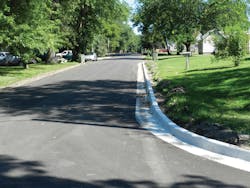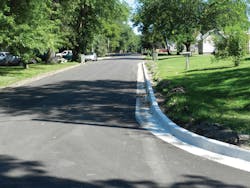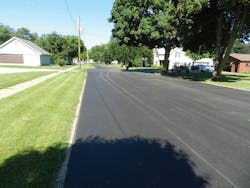He said anything
Christopher Columbus was a man with a vision. Meriwether Lewis and William Clark were men with a vision. Brian Devick, mayor of Woodward, Iowa, too is a man of vision.
The citizens of this small, central Iowa town will benefit from his vision for decades to come. In the summer of 2015, the vision of Devick and the Woodward City Council was complete—the entire town was paved with new asphalt streets.
Something stuck
Devick was elected mayor of Woodward in 2012 after serving on the Woodward City Council and working on the Planning & Zoning Commission in both Des Moines and Dallas counties.
“I remember being at an early city council meeting when one of the citizens, very angry at the time, shouted at the council, ‘If you are going to spend money on anything in this city, fix the damn streets!’ That really struck me and I never forgot it.”
In the fall of 2013, Devick and the city council began researching the possibility of paving the city’s streets. They began with doing the right legwork: They called a local contractor, Des Moines Asphalt & Paving (DMAP),
and asked for a budget price to put
2 in. of asphalt atop all their streets. In early 2014, they invited the estimator from DMAP, along with Bill Rosener, executive vice president of the Asphalt Paving Association of Iowa (APAI), and Tony Bellizzi, city engineer and vice president of Veenstra & Kimm (V&K) Engineers, to a fact-finding meeting with city officials. The meeting allowed the city councilmen to ask the myriad questions that concerned them. The meeting ended with a consensus—the project should be professionally designed. In June 2014, the city sent V&K a contract to design the town’s paving project with special emphasis on improving drainage. While Bellizzi and Co. began work on the details, the mayor and city council took the plan to the streets and asked the citizens for their input.
Woodward township officials contracted V&K Engineers for a community-wide paving project with an emphasis on drainage improvement.
A wealth of acceptance
The city of Woodward is a typical small town in Iowa. The city is a bedroom community for the city of Des Moines, with a population of 1,400 and approximately 400 households. More than 30% of the residents are of retirement age, but it boasts a strong group of young families. Woodward is a town where you see children playing on the streets until dark and neighbors visiting each other on their golf carts. The city has benefitted from being a hub of Iowa’s famous Trestle Bridge Bike Trail, which brings thousands of visitors to the town each summer.
“This is a blue-collar town; we’re not a wealthy town by any stretch of the imagination,” said Devick. “We are primarily residential. Our two biggest commercial businesses are the hospital and the school, both of which are tax-exempt.” In preparation for the street paving project, the city held two town hall meetings attended by approximately 80 people. According to Devick, more than 90% of those attending wanted to see the paving plan happen; of those, half wanted to see it done no matter what, the other 50% said only go ahead with the project if it could be completed without taxes going up. This was where the strength of Devick’s vision and the willingness of the city council to make the investment in the city infrastructure drove the project to becoming a reality. The next step was to review the plan developed by V&K Engineers.
How much are we looking at?
In the fall of 2014, Bellizzi presented the initial findings to the council with a draft plan for overlaying the city’s streets and addressing drainage issues. The project called for overlaying the existing sealcoat streets with hot-mix asphalt (HMA) at a depth of 3-4 in., strengthening pavement edges with HMA base repair, three linear blocks of concrete curb and gutter, 172 handicap ramps, a storm sewer, culverts, ditch improvements, and a large 8-ft × 5-ft box culvert.
“We cut a lot of cores in the existing streets to determine what type of structure we had,” said Bellizzi. “The city had made an investment with their chip-seal streets by placing a strong rock base. We were able to use an asphalt design that we have had success with in many small towns. With a good base, and good drainage, we were comfortable specifying a 3- to 4-in. overlay. We can add structure or do a mill-and-fill operation in the future. They have the basis of a perpetual pavement design that will serve the taxpayers for decades to come.”
As with all things, the Woodward project came down to money. V&K estimated the job at $3.2 million;
$1.4 million for drainage remediation and $1.8 million for the base repair, curb and gutter and paving. The mayor and council went to work.
It’s never been cheaper
Mayor Devick is a believer in his city. He also is a pragmatic man. The city could not put itself into a financial hole with this project. He discussed the city’s expenditures on the upkeep of the sealcoat streets with Woodward Public Works Director Chris Newland. “In the 10 years previous, we spent upwards of $640,000 on maintaining our sealcoat streets—it was not sustainable,” Newland said.
Devick's true vision came in his ability to drive the initiative at the right time and to utilize all the funding mechanisms available to the city.
The Iowa legislature had just passed an additional 10-cent gas tax increase that would mean an additional $50,000+ for the city of Woodward in Road Use Tax Funds (RUTF) each year. The city just finished paying off a bond for the rehabilitation of Main Street in 2014. The additional bonding capacity offered them $1.8 million at historically low interest rates with the remaining $1.4 million coming through a private loan against future RUTF monies. This gave the city the funds needed to meet the project budget of $3.2 million.
“To do this project piece by piece would have been too costly; I told our citizens that ‘asphalt will never be cheaper than it is right now,’” said Devick. By extending the bonding capacity, and rededicating the dollars spent on yearly maintenance of the sealcoat roads, the city of Woodward was able to fully fund the project without raising the taxes of its citizens. The scale of the project insured they would have competitive bids and lower per-ton pricing for their asphalt. The project letting was set for spring 2015.
An exisiting strong rock base allowed V&K to recommend a 3- to 4-in. hot-mix asphalt overlay, with conditional stabilization, for Woodward.
Not much to complain about
Grimes Asphalt and Paving Corp. of Des Moines was the low bidder on the project with a bid of $2.9 million. Survey and layout for the project began in March and April by V&K Engineers with the drainage work beginning in early May. Because of the early start, Grimes Asphalt was able to commit two crews to getting the project ready to pave. As with many sealcoat streets, the streets varied in width, and there were drainage issues that had been overlooked in the past. Streets needed to have new centerlines established, the weak areas needed to be cored out and beefed up with asphalt strengthening, new drainage channels needed to be cut and culvert pipes placed where necessary.
The project called for a 1- to 2-in. intermediate/leveling course of a 300k ESAL ½-in. HMA mix and a 2-in. surface course of a 300k ESAL ½-in. HMA mix. Both mixes were produced with a PG 64-22 binder. The intermediate/leveling course was designed to provide grade correction, add strength where needed, and provide a smooth base for the surface course. In addition, the project gave the city of Woodward the opportunity to make the city’s handicap ramps ADA-compliant.
The project was divided into five phases to limit inconvenience to the townspeople. “We had some complaining to start with,” said Newland, “but that quit as soon as the paving started.” Matt Yonker was the project manager from Grimes Asphalt: “We had to do a lot of coordination on this project. We handed out notices when we would be working on their streets. The people of Woodward are very nice and appreciative. We did a smaller, similar project for the city of Des Moines—I took 20 calls a day on that job. We have paved this entire town and I had just four calls.”
Bellizzi added, “You are always going to have some issues. There was a lot happening here all at once. The big benefit of asphalt is that you can open the streets as soon as you are done paving. You can’t do that with concrete.”
This is how it’s done
The project was completed in August 2015 with more than 20,000 tons of asphalt placed and the drainage work completed. The project was awarded an Asphalt Paving Association of Iowa (APAI) Award for the best municipal paving project in a city under 10,000 citizens. APAI’s Bill Rosener said of the project, “This project was a collaboration of one city’s vision, an engineer’s wisdom, and a contractor’s willingness to perform at the highest level. The municipal paving award could not have gone to a better representative of what can be achieved when men and women of vision work together to make the lives of their citizens better.”
The three men are pleased with how the vision that was created has become a reality. Woodward resident Deb Gilbert remarked, “I’m very happy with the streets. It’s great to see all the kids come out with their bikes, skateboards and roller-skates as soon as the road was finished.”
“I’m extremely proud of this project. We were able to address the No. 1 issue in this town without raising our citizen’s taxes,” said Devick. “This is how a city should do a project—we are getting the best product, the best pricing and the best quality.” Wise words spoken by a man of vision.


